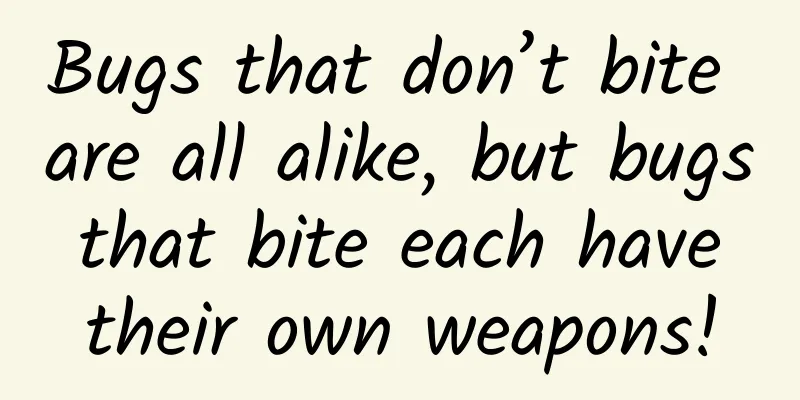Bugs that don’t bite are all alike, but bugs that bite each have their own weapons!

|
Author: Ji Qiaoqiao (Northeast Institute of Geography and Agroecology, Chinese Academy of Sciences) The article comes from the Science Academy official account (ID: kexuedayuan) —— (Warm Tips: This article contains some real pictures of insects. Although you will find their cuteness if you observe them carefully, readers who are really afraid of them should be careful~) There are many insects of various sizes and shapes around us, in parks, campuses, lakeside, groves, and even in our homes. As long as you observe carefully, you will definitely find something. Many parents will tell their children not to touch insects because they will bite (I was deceived this way). The insects are so wronged. When I officially came into contact with these little guys, I found that they were more afraid of us. What equipment do you need for insect bites? In fact, only a small number of insects around us are equipped with (special) mouthparts to bite people. What exactly are mouthparts? There are five main types of common mouthparts of insects: siphoning, licking, piercing-sucking, chewing, and chewing-sucking. Siphon mouthparts The siphon mouthparts (Figure 1) can be rolled up and down like a spring. Butterflies use them to suck nectar. They are soft and super flexible, and can be twisted and folded at will according to the shape of the flower. Figure 1 (Image source: Wikipedia) Licking and sucking mouthparts I don’t know if you have ever observed a fly eating. There is a structure under its head that looks like a toilet plunger (Figure 2), which is always touching the food (even if it is not eating, it will touch everything with its lips one by one). This is a licking-suction mouthpart, which does not have the function of biting. Figure 2 (Source: pixabay) However, I still recommend that you don't play with flies casually. On the one hand, I don't like flies (because they may be born in stinky poop, eat stinky poop, and then fly around with the stinky poop residue); on the other hand, they carry many bacteria and viruses, especially for those who don't have the habit of washing their hands before meals, they are potential killers. This kind of creature will not bite you, but it will disgust you... Piercing-sucking mouthparts Mosquitoes are also well-known insects, so how do they suck blood? Their mouthparts may look like a thin stick to the naked eye, but they actually contain a secret (Figure 3). Figure 3 (Image source: Wikipedia) What we usually see is the lower lip, which contains the upper and lower jaws that can pierce the skin. These two parts pierce the skin and enter the blood vessels. Before they can find the blood vessels, they have to keep probing between the tissues, and they cannot get blood in one go (as shown in Figure 4). Figure 4 (recorded by Valerie Choumet et al.) The mosquito's saliva contains anticoagulant and anesthetic components, which reduce the risk of interruption of blood-sucking activities. When they suck blood, blood-sucking and "injection" are carried out at the same time, that is, when mosquitoes suck your blood, they do not use only one needle to prick you, but several appendages perform minimally invasive dissection on you at the same time. Figure 5 (recorded by Valerie Choumet et al.) Chewing and sucking mouthparts The chewing and sucking mouthparts are the same as those of bees. Since bees can sting people, I guess we don’t have much chance to observe what their mouthparts look like. Figure 6 (Source: Guokr Public Account) When bees feed on nectar, the labial whiskers and the outer maxilla form a tube, and the brush-like middle labial tongue moves back and forth to lick the nectar. Scientists use microscopes and high-speed photography to record the process of bees drinking nectar, just like our pets drinking water, licking with their tongues (Figure 7). If the brush is not enough, speed can make up for it. Figure 7 (Source: Guokr Public Account) Chewing mouthparts The last type of mouthparts are the ones that can really bite people. They are chewing mouthparts, which are suitable for eating and chewing solid food. The specific structure of locusts is shown in Figure 8: Figure 8 (Image source: Baidu Encyclopedia) Locusts have an astonishing appetite, mainly feeding on grasses (crops). Coupled with their rapid reproduction rate, they often cause locust plagues. A few months ago, a large army of locusts in East Africa quickly crossed the Red Sea and spread to many countries in Asia, causing a food security crisis in many countries. Figure 9 (Image source: Wikipedia) In addition to locusts, ants can also bite people very hard. We all know that ants are very strong, and the pain caused by different species of ants is different. Don't ask me how I know this (눈_눈). They have mouthparts of different shapes, just to remind everyone: Don't mess with me, or I'll bite you! Figure 10 (Image source: pixabay) I don't know how many people have been bitten by dragonflies. Yes, the dragonflies we used to play with when we were young can bite people! Of course, if you play with it correctly, it's not a big problem, but be careful, no zuo no die. Figure 11 (Image source: Pexels) There are also ground beetles (Figure 12), tiger beetles (Figure 13), mantises (Figure 14), etc., who are not good guys either. They have equipment to protect themselves, so they are not afraid of you. No matter whether they can beat you or not, they will fight you to the death. Figure 12 (Image source: pixabay) Figure 13 (Source: pixabay) Figure 14 (Source: pixabay) To summarize how to judge the danger level of insects: Generally, more powerful insects have particularly protruding and large eyes, move quickly, look fierce, and may carry weapons (needles, thorns, hairs or defensive liquids, etc.). The evolution of insect mouthparts In fact, there is an evolutionary relationship between the various mouthparts of insects. Compared with most types of mouthparts in the modern world, chewing mouthparts are more primitive in structure. According to fossil records, the Devonian period (about 360-400 million years ago) was the initial stage of insect evolution, and chewing mouthparts were the typical representative. Siphoning, chewing-sucking, piercing-sucking, etc. are the result of chewing mouthpart insects becoming extreme in order to survive better. Taking these three types of mouthparts as examples, the origin of each part of their structure is shown in Figure 15 (see Figure 3 for abbreviations and annotations). Figure 15 (Image source: Wikipedia) Building a harmonious society with insects As a result of long-term coexistence with humans, insects in our daily lives do little harm to us, and most of them are not aggressive. Most of the aggressive ones fight back because they feel their lives are threatened, but this fightback may cause them to become disabled or even kill them, but for us, it is just pain or discomfort for a while, and then it will recover. In comparison, their cost is greater. If you are afraid of them, just stay away from them. If you want to challenge yourself, you will only get bitten a few times and feel pain, but your life is rarely in danger. Of course, we do not encourage you to fight with insects~ Please treat the insects around us kindly. You may not like them, but their ecological niche in nature is difficult to be replaced; at the same time, please do not bring a group from a faraway place to another place just because you like them, as this may cause them to reproduce recklessly due to the lack of natural enemies, thus leading to biological invasion. PS: This article is aimed at insects (six legs). Multi-legged spiders, ticks, mites, scorpions, centipedes, etc. do not count! References: [1] Cai Wanzhi et al. General Entomology. China Agricultural University Press, 2011. [2] Zhang Weiwei. Genealogy of Insects. Chongqing University Press, 2014. [3] Ren Dong. Diversity and evolutionary history of insect mouthparts, 2004. [4]Blackwell. The insects:an outline of entomology, 2014. |
>>: The sweetness that you can't let go of, is it all the taste of sugar?
Recommend
Is the new coronavirus a "super mutation"? A picture to understand "Omicron"
Recently, the new coronavirus variant "Omicr...
"Dragon Fighter" TV version trial play: I am not a dragon, please call me a self-destructing warrior
Since the Balala the Fairies game and the movie w...
How to apply for WeChat Video Account? How to use WeChat Video Account?
At the beginning of 2020, in a video speech at th...
Language is an interface
I translated some chapters from a book on uxpin c...
Will 8K TVs become the mainstream in the market? The reasons are beyond words
For most users, 4K TV is still a novelty. However...
Why Public Wi-Fi Is Unsafe
We often hear warnings from security experts that...
The fourth course of Qihangge video account
Course Catalog Dagang: 1. Video account recommend...
Can clothes cause cancer? Carcinogens that are easily overlooked in daily life
Recently, the State Administration for Market Reg...
It is said that product and marketing experts all "understand human nature". How can you do that?
After working in the product and marketing fields...
Without channel traffic tracking and analysis, no matter how much money you spend on APP promotion, it will be in vain!
Local promotion is an effective way for App to ac...
2015: A New Era of Mobile Payment
[[125693]] On December 28, the American technolog...
The dog's "head tilt" is not just for cuteness! There are also these reasons...
This article was reviewed by Zhao Xumao, a young ...
How much does it cost to inject hyaluronic acid into the nose? Chongqing SEO website promotion is not popular, how to make spiders favor it
When it comes to SEO optimization, we will find t...
How to find accurate drainage methods?
There is a cruel fact: the online traffic dividen...









